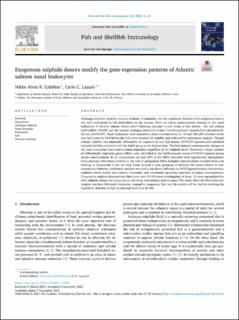| dc.contributor.author | Cabillon, Nikko Alvin | |
| dc.contributor.author | Lazado, Carlo C. | |
| dc.date.accessioned | 2021-11-29T10:53:57Z | |
| dc.date.available | 2021-11-29T10:53:57Z | |
| dc.date.created | 2021-11-26T12:39:40Z | |
| dc.date.issued | 2021 | |
| dc.identifier.citation | Fish and Shellfish Immunology. 2021, 120 1-10. | |
| dc.identifier.issn | 1050-4648 | |
| dc.identifier.uri | https://hdl.handle.net/11250/2831871 | |
| dc.description.abstract | Hydrogen sulphide (H2S) is a known mediator of immunity, but the regulatory function of its exogenous form is not well understood in fish particularly in the mucosa. Here we report transcriptomic changes in the nasal leukocytes of Atlantic salmon (Salmo salar) following exposure to two forms of H2S donors – the salt sodium hydrosulfide (NaHS) and the organic analogue morpholin-4-ium 4-methoxyphenyl (morpholino) phosphinodithioate (GYY4137). Nasal leukocytes were exposed to three concentrations (1, 10 and 100 μM) of either of the two H2S forms for 24 h before the cells were checked for viability and collected for microarray analysis. Though cellular viability was minimally affected by the exposure to two H2S donors, GYY4137-exposed cells exhibited reduced viability compared with the NaHS group at the highest dose. The H2S-induced transcriptomic changes in the nasal leukocytes were concentration-dependent regardless of the sulphide forms. However, a larger number of differentially expressed genes (DEGs) were identified in the NaHS-exposed versus GYY4137-exposed groups across concentrations. In all comparisons, at least 53% of the DEGs identified were significantly upregulated. Gene ontology (GO) terms enriched in the lists of upregulated DEGs at higher concentrations included ferric iron binding. A comparison of the two H2S forms showed a clear grouping of different GO terms relative to concentrations. Pathway enrichment analysis revealed a significant influence in VEGF ligand-receptor interactions, oxidative stress, innate and adaptive immunity, and interleukin signalling especially at higher concentrations. Congruence analysis demonstrated that there were 16 GO terms overlapping; of these, 12 were upregulated by both sulphide donors including several involving iron binding and transport. The study offers the first molecular insights into how fish nasal leukocytes respond to exogenous H2S, and the results will be vital in resolving the regulatory function of H2S on mucosal immunity in fish. | |
| dc.language.iso | eng | |
| dc.relation.uri | https://www.sciencedirect.com/science/article/pii/S1050464821003703 | |
| dc.title | Exogenous sulphide donors modify the gene expression patterns of Atlantic salmon nasal leukocytes | |
| dc.type | Peer reviewed | |
| dc.type | Journal article | |
| dc.description.version | publishedVersion | |
| dc.source.pagenumber | 1-10 | |
| dc.source.volume | 120 | |
| dc.source.journal | Fish and Shellfish Immunology | |
| dc.identifier.doi | 10.1016/j.fsi.2021.11.005 | |
| dc.identifier.cristin | 1959715 | |
| dc.relation.project | Norges forskningsråd: 237856 | |
| cristin.ispublished | true | |
| cristin.fulltext | original | |
| cristin.qualitycode | 1 | |
